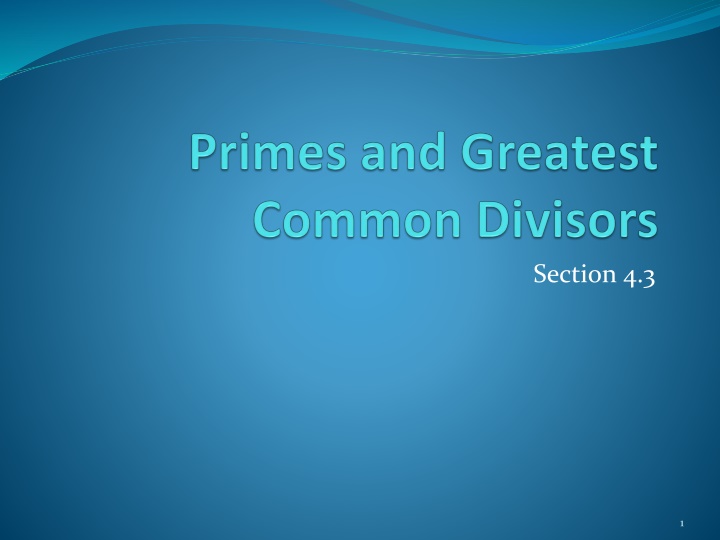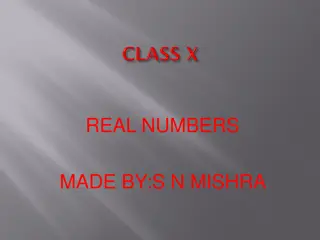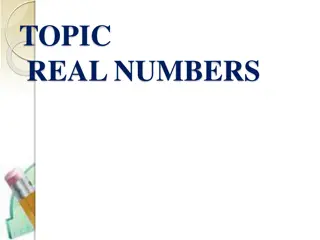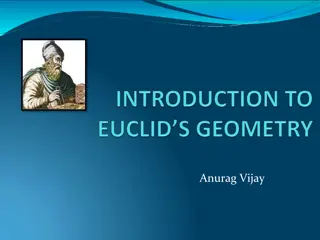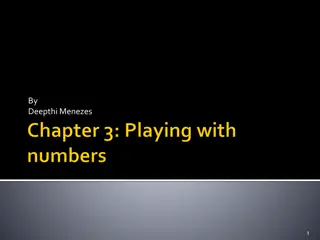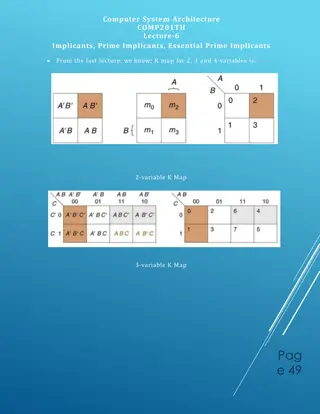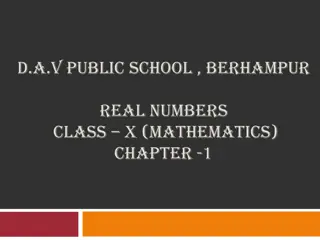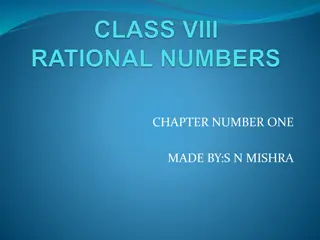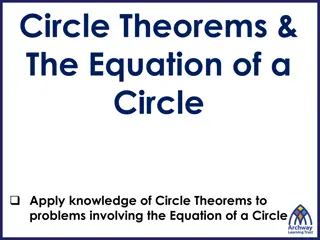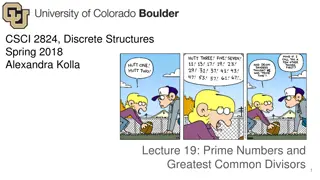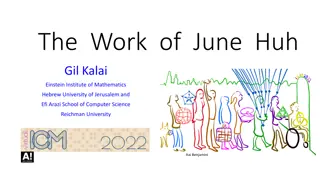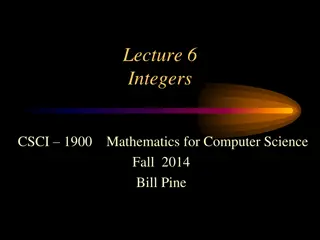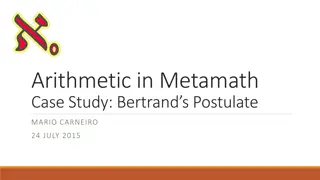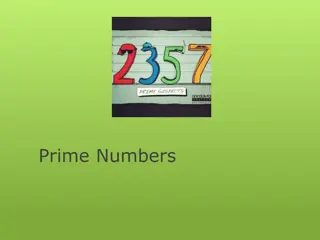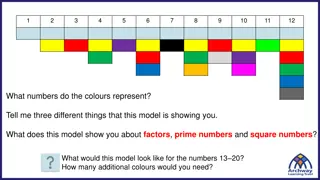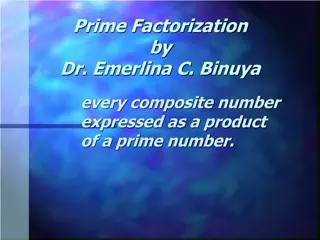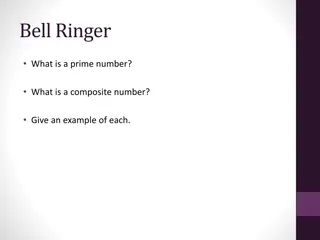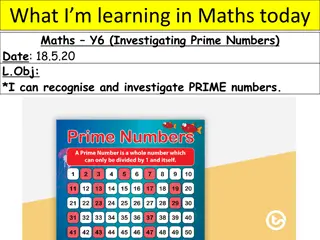Prime Numbers and Properties: Conjectures, Theorems, and Euclid's Contributions
Discover the fascinating world of prime numbers, their properties, and significant theorems such as the Fundamental Theorem of Arithmetic. Explore Eratosthenes' Sieve and Euclid's proof of the infinitude of primes. Dive into the definitions, examples, and methods of identifying prime numbers. Uncover the beauty of mathematics through the exploration of prime numbers and their applications in various fields.
Download Presentation

Please find below an Image/Link to download the presentation.
The content on the website is provided AS IS for your information and personal use only. It may not be sold, licensed, or shared on other websites without obtaining consent from the author.If you encounter any issues during the download, it is possible that the publisher has removed the file from their server.
You are allowed to download the files provided on this website for personal or commercial use, subject to the condition that they are used lawfully. All files are the property of their respective owners.
The content on the website is provided AS IS for your information and personal use only. It may not be sold, licensed, or shared on other websites without obtaining consent from the author.
E N D
Presentation Transcript
Section Summary Prime Numbers and their Properties Conjectures and Open Problems About Primes Greatest Common Divisors and Least Common Multiples The Euclidian Algorithm gcds as Linear Combinations 2
Primes Definition: A positive integer p greater than 1 is called prime if the only positive factors of p are 1 and p. A positive integer that is greater than 1 and is not prime is called composite. Example: The integer 7 is prime because its only positive factors are 1 and 7, but 9 is composite because it is divisible by 3. 3
The Fundamental Theorem of Arithmetic Theorem: Every positive integer greater than 1 can be written uniquely as a prime or as the product of two or more primes where the prime factors are written in order of nondecreasing size. Examples: 100 = 2 2 5 5 = 22 52 641 = 641 999 = 3 3 3 37 = 33 37 1024 = 2 2 2 2 2 2 2 2 2 2 = 210 4
Erastothenes (276-194 B.C.) The Sieve of Eratosthenes The Sieve of Eratosthenes can be used to find all primes not exceeding a specified positive integer. For example, begin with the list of integers between 1 and 100. Delete all the integers, other than 2, divisible by 2. Delete all the integers, other than 3, divisible by 3. Next, delete all the integers, other than 5, divisible by 5. Next, delete all the integers, other than 7, divisible by 7. Since all the remaining integers are not divisible by any of the previous integers, other than 1, the primes are: {2,3,7,11,19,23,29,31,37,41,43,47,53,59,61,67,71,73,79,83,89, 97} a. b. c. d. e. continued 5
The Sieve of Eratosthenes If an integer n is a composite integer, then it has a prime divisor less than or equal to n. To see this, note that if n = ab, then a n or b n. Trial division, a very inefficient method of determining if a number n is prime, is to try every integer i n and see if n is divisible by i. 6
Infinitude of Primes Euclid (325B.C.E. 265B.C.E.) Theorem: There are infinitely many primes. (Euclid) Proof: Assume finitely many primes: p1, p2, .., pn Let q = p1p2 pn + 1 Either q is prime or by the fundamental theorem of arithmetic it is a product of primes. But none of the primes pj divides q since if pj | q, then pj divides q p1p2 pn = 1 . Hence, there is a prime not on the list p1, p2, .., pn.It is either q, or if q is composite, it is a prime factor of q. This contradicts the assumption that p1, p2, .., pn are all the primes. Consequently, there are infinitely many primes. This proof was given by Euclid The Elements. The proof is considered to be one of the most beautiful in all mathematics. It is the first proof in The Book, inspired by the famous mathematician Paul Erd s imagined collection of perfect proofs maintained by God. Paul Erd s (1913-1996) 7
Marin Mersenne (1588-1648) Mersenne Primes Definition: Prime numbers of the form 2 2p p prime, are called Mersenne primes. 22 1 = 3, 23 1 = 7, 25 1 = 31 , and 27 1 = 127 are Mersenne primes. 211 1 = 2047 is not a Mersenne primesince 2047 = 23 89. There is an efficient test for determining if 2p 1 is prime. The largest known prime numbers are Mersenne primes. As of mid 2011, 47 Mersenne primes were known, the largest is 243,112,609 1, which has nearly 13 million decimal digits. The Great Internet Mersenne Prime Search (GIMPS) is a distributed computing project to search for new Mersenne Primes. http://www.mersenne.org/ 1 1 , , wherep is 8
Distribution of Primes Mathematicians have been interested in the distribution of prime numbers among the positive integers. In the nineteenth century, the prime number theorem was proved whichgives an asymptotic estimate for the number of primes not exceeding x. Prime Number Theorem: The ratio of the number of primes not exceeding x and x/ln x approaches 1 as x grows without bound. (ln x is the natural logarithm of x) The theorem tells us that the number of primes not exceeding x, can be approximated by x/ln x. The odds that a randomly selected positive integer less than n is prime are approximately (n/ln n)/n = 1/ln n. 9
Primes and Arithmetic Progressions (optional) Euclid s proof that there are infinitely many primes can be easily adapted to show that there are infinitely many primes in the following 4k + 3, k = 1,2, (See Exercise 55) In the 19th century G. Lejuenne Dirchlet showed that every arithmetic progression ka + b, k = 1,2, , where a and b have no common factor greater than 1 contains infinitely many primes. (The proof is beyond the scope of the text.) Are there long arithmetic progressions made up entirely of primes? 5,11, 17, 23, 29 is an arithmetic progression of five primes. 199, 409, 619, 829, 1039,1249,1459,1669,1879,2089 is an arithmetic progression of ten primes. In the 1930s, Paul Erd s conjectured that for every positive integer n greater than 1, there is an arithmetic progression of length n made up entirely of primes. This was proven in 2006, by Ben Green and Terrence Tau. Terence Tao (Born 1975) 10
Generating Primes The problem of generating large primes is of both theoretical and practical interest. We will see (in Section 4.6) that finding large primes with hundreds of digits is important in cryptography. So far, no useful closed formula that always produces primes has been found. There is no simple function f(n) such that f(n) is prime for all positive integers n. But f(n) = n2 n + 41 is prime for all integers 1,2, , 40. Because of this, we might conjecture that f(n) is prime for all positive integers n. But f(41) = 412 is not prime. More generally, there is no polynomial with integer coefficients such that f(n) is prime for all positive integers n. (See supplementary Exercise 23.) Fortunately, we can generate large integers which are almost certainly primes. See Chapter7. 11
Conjectures about Primes Even though primes have been studied extensively for centuries, many conjectures about them are unresolved, including: Goldbach s Conjecture: Every even integer n, n > 2, is the sum of two primes. It has been verified by computer for all positive even integers up to 1.6 1018. The conjecture is believed to be true by most mathematicians. There are infinitely many primes of the form n2 + 1, where n is a positive integer. But it has been shown that there are infinitely many primes of the form n2 + 1, where n is a positive integer or the product of at most two primes. The Twin Prime Conjecture: The twin prime conjecture is that there are infinitely many pairs of twin primes. Twin primes are pairs of primes that differ by 2. Examples are 3 and 5, 5 and 7, 11 and 13, etc. The current world s record for twin primes (as of mid 2011) consists of numbers 65,516,468,355 2333,333 1, which have 100,355 decimal digits. 12
Greatest Common Divisor Definition: Let a and b be integers, not both zero. The largest integer d such that d | a and also d | b is called the greatest common divisor of a and b. The greatest common divisor of a and b is denoted by gcd(a,b). One can find greatest common divisors of small numbers by inspection. Example:What is the greatest common divisor of 24 and 36? Solution: gcd(24,26) = 12 Example:What is the greatest common divisor of 17 and 22? Solution: gcd(17,22) = 1 13
Greatest Common Divisor Definition: The integers a and b are relatively prime if their greatest common divisor is 1. Example: 17 and 22 Definition: The integers a1, a2, , an are pairwiserelatively prime if gcd(ai, aj)= 1 whenever 1 i<j n. Example: Determine whether the integers 10, 17 and 21 are pairwise relatively prime. Solution: Because gcd(10,17) = 1, gcd(10,21) = 1, and gcd(17,21) = 1, 10, 17, and 21 are pairwise relatively prime. Example: Determine whether the integers 10, 19, and 24 are pairwise relatively prime. Solution: Because gcd(10,24) = 2, then10, 19, and 24 are not pairwise relatively prime. 14
Finding the Greatest Common Divisor Using Prime Factorizations Suppose the prime factorizations of a and b are: where each exponent is a nonnegative integer, and where all primes occurring in either prime factorization are included in both. Then: This formula is valid since the integer on the right (of the equals sign) divides both a and b. No larger integer can divide both a and b. Example: 120 = 23 3 5 500 = 22 53 gcd(120,500) = 2min(3,2) 3min(1,0) 5min(1,3) = 22 30 51 = 20 Finding the gcd of two positive integers using their prime factorizations is NOT efficient because there is no efficient algorithm for finding the prime factorization of a positive integer. 15
Least Common Multiple Definition: The least common multiple of the positive integers a and b is the smallest positive integer that is divisible by both a and b. It is denoted by lcm(a,b). The least common multiple can also be computed from the prime factorizations. This number is divided by both a and b and no smaller number is divided by a and b. Example: lcm(233572, 2433) = 2max(3,4) 3max(5,3) 7max(2,0) = 24 35 72 The greatest common divisor and the least common multiple of two integers are related by: Theorem 5 5: Let a and b be positive integers. Then ab = gcd(a,b) lcm(a,b) (proof is Exercise 31) 16
Euclidean Algorithm Euclid (325B.C.E. 265B.C.E.) The Euclidian algorithm is an efficient method for computing the greatest common divisor of two integers. It is based on the idea that gcd(a,b) is equal to gcd(a,c) when a>b and c is the remainder when a is divided by b. Example: Find gcd(287, 91): 287 = 91 3 + 14 Divide 287 by 91 91 = 14 6 + 7 Divide 91 by 14 14 = 7 2 + 0 Divide 14 by 7 Stopping condition gcd(287, 91) = gcd(91, 14) = gcd(14, 7) = 7 continued 17
Euclidean Algorithm The Euclidean algorithm expressed in pseudocode is: proceduregcd(a, b: positive integers) x := a y := b while y 0 r := xmody x := y y := r returnx {gcd(a,b) is x} Assignment: Implement this algorithm. In Section 5.3, we ll see that the time complexity of the algorithm is O(log b), where a > b. 18
Correctness of Euclidean Algorithm Lemma 1 1: Let a = bq + r, where a, b, q, and r are integers. Then gcd(a,b) = gcd(b,r). Proof: Suppose that d divides both a and b. Then d also divides a bq = r (by Theorem 1 of Section 4.1). Hence, any common divisor of a and b must also be any common divisor of b and r. Suppose that d divides both b and r. Then d also divides bq + r = a. Hence, any common divisor of a and b must also be a common divisor of b and r. Therefore, gcd(a,b) = gcd(b,r). S.S .to S. 20 19
Correctness of Euclidean Algorithm Suppose that a and b are positive integers with a b. Let r0 = a and r1 = b. Successive applications of the division algorithm yields: r0= r1q1 + r20 r2 < r1, r1= r2q2 + r30 r3 < r2, rn-2= rn-1qn-1 + r20 rn < rn-1, rn-1= rnqn . Eventually, a remainder of zero occurs in the sequence of terms: a = r0 > r1 > r2 > 0. The sequence can t contain more than a terms. By Lemma 1 gcd(a,b) = gcd(r0,r1) = = gcd(rn-1,rn) = gcd(rn , 0) = rn. Hence the greatest common divisor is the last nonzero remainder in the sequence of divisions. S.S .to S. 20 20
tienne Bzout (1730-1783) gcds as Linear Combinations B zout s Theorem: If a and b are positive integers, then there exist integers s and t such that gcd(a,b) = sa + tb. (proof in exercises of Section 5.2) Definition: If a and b are positive integers, then integers s and t such that gcd(a,b) = sa + tb are called B zout coefficients of a and b. The equation gcd(a,b) = sa + tb is calledB zout s identity. By B zout s Theorem, the gcd of integers a and b can be expressed in the form sa + tb where s and t are integers. This is a linear combination with integer coefficients of a and b. gcd(6,14) = ( 2) 6 + 1 14 21
Finding gcds as Linear Combinations Example: Express gcd(252,198) = 18 as a linear combination of 252 and 198. Solution: First use the Euclidean algorithm to show gcd(252,198) = 18 252 = 1 198 + 54 198 = 3 54 + 36 54 = 1 36 + 18 36 = 2 18 Now working backwards, from iii to i above 18 = 54 1 36 36 = 198 3 54 Substituting the 2nd equation into the 1st yields: 18 = 54 1 (198 3 54 )= 4 54 1 198 Substituting 54 = 252 1 198 (from i)) yields: 18 = 4 (252 1 198) 1 198 = 4 252 5 198 This method illustrated above is a two pass method. It first uses the Euclidian algorithm to find the gcd and then works backwards to express the gcd as a linear combination of the original two integers. A one pass method, called the extended Euclidean algorithm, is developed in the exercises. i. ii. iii. iv. 22
Consequences of Bzouts Theorem Lemma 2 2: If a, b, and c are positive integers such that gcd(a, b) = 1 and a | bc, then a | c. Proof: Assume gcd(a, b) = 1 and a | bc Since gcd(a, b) = 1, by B zout s Theorem there are integers s and t such that sa + tb = 1. Multiplying both sides of the equation by c, yields sac + tbc = c. From Theorem 1 of Section 4.1: a | tbc (part ii) and a divides sac + tbc since a | sac and a|tbc (part i) We conclude a | c, since sac + tbc = c. Lemma 3 3: If p is prime and p | a1a2 an, then p | ai for some i. (proof uses mathematical induction; see Exercise 64 of Section 5.1) Lemma 3 is crucial in the proof of the uniqueness of prime factorizations. 23
Uniqueness of Prime Factorization We will prove that a prime factorization of a positive integer where the primes are in nondecreasing order is unique. (This is part of the fundamental theorem of arithmetic. The other part, which asserts that every positive integer has a prime factorization into primes, will be proved in Section 5.2.) Proof: (by contradiction) Suppose that the positive integer n can be written as a product of primes in two distinct ways: n = p1p2 psand n = q1q2 qt. Remove all common primes from the factorizations to get By Lemma 3, it follows that divides , for some k, contradicting the assumption that and are distinct primes. Hence, there can be at most one factorization of n into primes in nondecreasing order. 24
Dividing Congruences by an Integer Dividing both sides of a valid congruence by an integer does not always produce a valid congruence (see Section 4.1). But dividing by an integer relatively prime to the dividing by an integer relatively prime to the modulus modulus does produce a valid congruence: Theorem 7: Let m be a positive integer and let a, b, and c be integers. If ac bc (mod m) and gcd(c,m) = 1, then a b (mod m). Proof: Since ac bc (mod m), m | ac bc = c(a b) by Lemma 2 and the fact that gcd(c,m) = 1, it follows that m | a b. Hence,a b (mod m). 25
Section 4.4 26
Section Summary Linear Congruences The Chinese Remainder Theorem Computer Arithmetic with Large Integers (not currently included in slides, see text) Fermat s Little Theorem Pseudoprimes Primitive Roots and Discrete Logarithms 27
Linear Congruences Definition: A congruence of the form ax b( mod m), where m is a positive integer, a and b are integers, and x is a variable, is called a linear congruence. The solutions to a linear congruence ax b( mod m) are all integers x that satisfy the congruence. Definition: An integer such that a 1( mod m) is said to be an inverse of a modulo m. Example: 5 is an inverse of 3 modulo 7 since 5 3 = 15 1(mod 7) One method of solving linear congruences utilizes an inverse , if it exists. Although we can not divide both sides of the congruence by a, we can multiply by to solve for x. 28
Inverse of a modulo m The following theorem guarantees that an inverse of a modulo m exists whenever a and m are relatively prime. Two integers a and b are relatively prime when gcd(a,b) = 1. Theorem 1 1: If a and m are relatively prime integers and m > 1, then an inverse of a modulo m exists. Furthermore, this inverse is unique modulo m. (This means that there is a unique positive integer less than m that is an inverse of a modulo m and every other inverse of a modulo m is congruent to modulo m.) Proof: Since gcd(a,m) = 1, by Theorem 6 of Section 4.3, there are integers s and t such that sa + tm = 1. Hence, sa + tm 1 ( mod m). Since tm 0 ( mod m), it follows that sa 1 ( mod m) Consequently, s is an inverse of a modulo m. The uniqueness of the inverse is Exercise 7. 29
Finding Inverses The Euclidean algorithm and B zout coefficients gives us a systematic approaches to finding inverses. Example: Find an inverse of 3 modulo 7. Solution: Because gcd(3,7) = 1, by Theorem 1, an inverse of 3 modulo 7 exists. Using the Euclidian algorithm: 7 = 2 3 + 1. From this equation, we get 2 3 + 1 7 = 1, and see that 2 and 1 are B zout coefficients of 3 and 7. Hence, 2 is an inverse of 3 modulo 7. Also every integer congruent to 2 modulo 7 is an inverse of 3 modulo 7, i.e., 5, 9, 12, etc. 30
Finding Inverses Example: Find an inverse of 101 modulo 4620. Solution: First use the Euclidian algorithm to show that gcd(101,4620) = 1. Working Backwards: 1 = 3 1 2 1 = 3 1 (23 7 3) = 1 23 + 8 3 1 = 1 23 + 8 (26 1 23) = 8 26 9 23 1 = 8 26 9 (75 2 26)= 26 26 9 75 1 = 26 (101 1 75) 9 75 = 26 101 35 75 1 = 26 101 35 (4620 45 101) = 35 4620+1601 101 4620 = 45 101 + 75 101 = 1 75 + 26 75 = 2 26 + 23 26 = 1 23 + 3 23 = 7 3 + 2 3 = 1 2 + 1 2 = 2 1 Since the last nonzero remainder is 1, gcd(101,4620) = 1 1601 is an inverse of 101 modulo 4620 B zout coefficients : 35 and 1601 31
Using Inverses to Solve Congruences We can solve the congruence ax b( mod m) by multiplying both sides by . Example: What are the solutions of the congruence 3x 4( mod 7). Solution: We found that 2 is an inverse of 3 modulo 7 (two slides back). We multiply both sides of the congruence by 2 giving 2 3x 2 4(mod 7). Because 6 1 (mod 7) and 8 6 (mod 7), it follows that if x is a solution, then x 8 6 (mod 7) We need to determine if every x with x 6 (mod 7) is a solution. Assume that x 6 (mod 7). By Theorem 5 of Section 4.1, it follows that 3x 3 6 = 18 4( mod 7) which shows that all such x satisfy the congruence. The solutions are the integers x such that x 6 (mod 7), namely, 6,13,20 and 1, 8, 15, 32
The Chinese Remainder Theorem In the first century, the Chinese mathematician Sun-Tsu asked: There are certain things whose number is unknown. When divided by 3, the remainder is 2; when divided by 5, the remainder is 3; when divided by 7, the remainder is 2. What will be the number of things? This puzzle can be translated into the solution of the system of congruences: x 2 ( mod 3), x 3 ( mod 5), x 2 ( mod 7)? We ll see how the theorem that is known as the Chinese Remainder Theorem can be used to solve Sun-Tsu s problem. 33
The Chinese Remainder Theorem Theorem 2 2: (The Chinese Remainder Theorem) Let m1,m2, ,mn be pairwise relatively prime positive integers greater than one and a1,a2, ,an arbitrary integers. Then the system x a1( mod m1) x a2( mod m2) x an( mod mn) has a unique solution modulo m = m1m2 mn. (That is, there is a solution x with 0 x <m and all other solutions are congruent modulo m to this solution.) Proof: We ll show that a solution exists by describing a way to construct the solution. Showing that the solution is unique modulo m is Exercise 30. continued 34
The Chinese Remainder Theorem To construct a solution first let Mk=m/mk for k = 1,2, ,n and m = m1m2 mn. Since gcd(mk ,Mk ) = 1, by Theorem 1, there is an integer yk , an inverse of Mk modulo mk,such that Mkyk 1 ( mod mk ). Form the sum x = a1 1M1 1 y1 + a2 2M2 2 y2 2 + + + + anMn yn . 1 + Note that because Mj 0 ( mod mk) whenever j k , all terms except the kth term in this sum are congruent to 0 modulo mk . Because Mkyk 1 ( mod mk ), we see that x akMk yk ak( mod mk), for k = 1,2, ,n. Hence, x is a simultaneous solution to the n congruences. x a1( mod m1) x a2( mod m2) x an( mod mn) 35
The Chinese Remainder Theorem Example: Consider the 3 congruences from Sun-Tsu s problem: x 2 ( mod 3), x 3 ( mod 5), x 2 ( mod 7). Let m = 3 5 7 = 105, M1 = m/3 = 35,M2 = m/5 = 21, M3 = m/7 = 15. We see that 2 is an inverse of M1 = 35 modulo 3 since 35 2 2 2 1 (mod 3) 1 is an inverse of M2 = 21 modulo 5 since 21 1 (mod 5) 1 is an inverse of M3 = 15 modulo 7 since 15 1 (mod 7) Hence, x = a1M1y1 + a2M2y2 + a3M3y3 = 2 35 2 + 3 21 1 + 2 15 1 = 233 23 (mod 105) We have shown that 23 is the smallest positive integer that is a simultaneous solution. Check it! 36
Back Substitution (Optional) We can also solve systems of linear congruences with pairwise relatively prime moduli by rewriting a congruences as an equality using Theorem 4 in Section 4.1, substituting the value for the variable into another congruence, and continuing the process until we have worked through all the congruences. This method is known as back substitution. Example: Use the method of back substitution to find all integers x such that x 1 (mod 5), x 2 (mod 6), and x 3 (mod 7). Solution Solution: By Theorem 4 in Section 4.1, the first congruence can be rewritten as x = 5t +1, where t is an integer. Substituting into the second congruence yields 5t+1 2 (mod 6). Solving this tells us that t 5 (mod 6). Using Theorem 4 again gives t = 6u + 5 where u is an integer. Substituting this back into x = 5t +1, gives x = 5(6u + 5) +1 = 30u + 26. Inserting this into the third equation gives 30u+ 26 3 (mod 7). Solving this congruence tells us that u 6 (mod 7). By Theorem 4, u = 7v + 6, where v is an integer. Substituting this expression for u into x = 30u + 26, tells us that x = 30(7v + 6) + 26 = 210u + 206. Translating this back into a congruence we find the solution x 206 (mod 210). 37
Fermats Little Theorem Pierre de Fermat (1601-1665) Theorem 3 3: (Fermat s Little Theorem) If p is prime and a is an integer not divisible by p, then ap-1 1 1 (mod 1 (mod p) ) Furthermore, for every integer a we have ap (proof outlined in Exercise 19) a (mod (mod p) ) Fermat s little theorem is useful in computing the remainders modulo p of large powers of integers. Example:Find7222 mod 11. By Fermat s little theorem, we know that 710 1 (mod 11), and so (710 )k 1 (mod 11), for every positive integer k. Therefore, 7222 = 722 10 + 2 = (710)2272 (1)22 49 5 (mod 11). Hence, 7222 mod 11 = 5. 38
Pseudoprimes By Fermat s little theorem, if n > 2 is prime, then 2n-1 1 (mod n). But, if this congruence holds, n may not be prime. Composite integers n such that 2n-1 1 (mod n) are called pseudoprimes to the base 2. Example: The integer 341 is a pseudoprime to the base 2. 341 = 11 31 2340 1 (mod 341) (see in Exercise 37) We can replace 2 by any integer b 2. Definition: Let b be a positive integer. If n is a composite integer, and bn-1 1 (mod n), then n is called a pseudoprime to the base b. 39
Pseudoprimes Given a positive integer n, such that 2n-1 1 (mod n): If n does not satisfy the congruence, it is composite. If n does satisfy the congruence, it is either prime or a pseudoprime to the base 2. Doing similar tests with additional bases b, provides more evidence as to whether n is prime. Among the positive integers not exceeding a positive real number x, compared to primes, there are relatively few pseudoprimes to the base b. For example, among the positive integers less than 1010 there are 455,052,512 primes, but only 14,884 pseudoprimes to the base 2. 40
Carmichael Numbers (optional) Robert Carmichael (1879-1967) There are composite integers n that pass all tests with bases b such that gcd(b,n) = 1. Definition: A composite integer n that satisfies the congruence bn-1 1 (mod n) for all positive integers b with gcd(b,n) = 1 is called a Carmichael number. Example: The integer 561 is a Carmichael number. To see this: 561 is composite, since 561 = 3 11 13. If gcd(b, 561) = 1, then gcd(b, 3) = 1, then gcd(b, 11) = gcd(b, 17) =1. Using Fermat s Little Theorem: b2 1 (mod 3), b10 1 (mod 11), b16 1 (mod 17). Then b560 = (b2) 280 1 (mod 3), b560 = (b10) 56 1 (mod 11), b560 = (b16) 35 1 (mod 17). It follows (see Exercise 29)that b560 1 (mod 561) for all positive integers b with gcd(b,561) = 1. Hence, 561 is a Carmichael number. Even though there are infinitely many Carmichael numbers, there are other tests (described in the exercises) that form the basis for efficient probabilistic primality testing. (see Chapter 7) 41
S.S. to Slide 43 Primitive Roots Definition: A primitive root modulo a prime p is an integer r in Zp such that every nonzero element of Zp is a power of r. Example: Since every element of Z11 is a power of 2, 2 is a primitive root of 11. Powers of 2 modulo 11: 21 = 2, 22 = 4, 23 = 8, 24 = 5, 25 = 10, 26 = 9, 27 = 7, 28 = 3, 210 = 2. Example: Since not all elements of Z11 are powers of 3, 3 is not a primitive root of 11. Powers of 3 modulo 11: 31 = 3, 32 = 9, 33 = 5, 34 = 4, 35 = 1, and the pattern repeats for higher powers. Important Fact: There is a primitive root modulo p for every prime number p. 42
S.S. to Slide 43 Discrete Logarithms Suppose p is prime and r is a primitive root modulo p. If a is an integer between 1 and p 1, that is an element of Zp, there is a unique exponent e such that re = a in Zp, that is, re mod p = a. Definition: Suppose that p is prime, r is a primitive root modulo p, and a is an integer between 1 and p 1, inclusive. If re mod p = a and 1 e p 1, we say that e is the discrete logarithm of a modulo p to the base r and we write logra = e (where the prime p is understood). Example 1 Example 1: We write log2 3 = 8 since the discrete logarithm of 3 modulo 11 to the base 2 is 8 as 28 = 3 modulo 11. Example 2 Example 2: We write log2 5 = 4 since the discrete logarithm of 5 modulo 11 to the base 2 is 4 as 24 = 5 modulo 11. There is no known polynomial time algorithm for computing the discrete logarithm of a modulo p to the base r (when given the prime p, a root r modulo p, and a positive integer a Zp). The problem plays a role in cryptography as will be discussed in Section 4.6. 43
Section 4.5 Rest of this chapter is excluded from our syllabus 44
Section Summary Hashing Functions Pseudorandom Numbers Check Digits 45
Hashing Functions Definition: A hashing function h assigns memory location h(k) to the record that has k as its key. A common hashing function is h(k) = kmodm, where m is the number of memory locations. Because this hashing function is onto, all memory locations are possible. Example: Let h(k) = kmod111. This hashing function assigns the records of customers with social security numbers as keys to memory locations in the following manner: h(064212848) = 064212848 mod111 = 14 h(037149212) = 037149212 mod111 = 65 h(107405723) = 107405723 mod111 = 14, but since location 14 is already occupied, the record is assigned to the next available position, which is 15. The hashing function is not one-to-one as there are many more possible keys than memory locations. When more than one record is assigned to the same location, we say a collision occurs. Here a collision has been resolved by assigning the record to the first free location. For collision resolution, we can use a linear probing function: h(k,i) = (h(k) + i) modm, where i runs from 0 to m 1. There are many other methods of handling with collisions. You may cover these in a later CS course. 46
Pseudorandom Numbers Randomly chosen numbers are needed for many purposes, including computer simulations. Pseudorandom numbers are not truly random since they are generated by systematic methods. The linear congruential method is one commonly used procedure for generating pseudorandom numbers. Four integers are needed: the modulusm, the multipliera, the incrementc, and seedx0, with 2 a < m, 0 c < m, 0 x0 < m. We generate a sequence of pseudorandom numbers {xn}, with 0 xn < m for all n, by successively using the recursively defined function (an example of a recursive definition, discussed in Section 5.3) If psudorandom numbers between 0 and 1 are needed, then the generated numbers are divided by the modulus, xn /m. xn+1 = (axn + c) modm. 47
Pseudorandom Numbers Example: Find the sequence of pseudorandom numbers generated by the linear congruential method with modulus m = 9, multiplier a = 7, increment c = 4, and seed x0 = 3. Solution: Compute the terms of the sequence by successively using the congruence xn+1 = (7xn + 4) mod 9, with x0 = 3. x1 = 7x0 + 4mod 9 = 7 3 + 4 mod 9 = 25 mod 9 = 7, x2 = 7x1 + 4mod 9 = 7 7 + 4 mod 9 = 53 mod 9 = 8, x3 = 7x2 + 4mod 9 = 7 8 + 4 mod 9 = 60 mod 9 = 6, x4 = 7x3 + 4mod 9 = 7 6 + 4 mod 9 = 46 mod 9 = 1, x5 = 7x4 + 4mod 9 = 7 1 + 4 mod 9 = 11 mod 9 = 2, x6 = 7x5 + 4mod 9 = 7 2 + 4 mod 9 = 18 mod 9 = 0, x7 = 7x6 + 4mod 9 = 7 0 + 4 mod 9 = 4 mod 9 = 4, x8 = 7x7 + 4mod 9 = 7 4 + 4 mod 9 = 32 mod 9 = 5, x9 = 7x8 + 4mod 9 = 7 5 + 4 mod 9 = 39 mod 9 = 3. The sequence generated is 3,7,8,6,1,2,0,4,5,3,7,8,6,1,2,0,4,5,3, It repeats after generating 9 terms. Commonly, computers use a linear congruential generator with increment c = 0. This is called a pure multiplicative generator. Such a generator with modulus 231 1 and multiplier 75 = 16,807 generates 231 2 numbers before repeating. 48
Check Digits: UPCs A common method of detecting errors in strings of digits is to add an extra digit at the end, which is evaluated using a function. If the final digit is not correct, then the string is assumed not to be correct. Example: Retail products are identified by their Universal Product Codes (UPCs). Usually these have 12 decimal digits, the last one being the check digit. The check digit is determined by the congruence: 3x1 + x2 + 3x3 + x4 + 3x5 + x6 + 3x7 + x8 + 3x9 + x10 + 3x11 + x12 0 (mod10). a. Suppose that the first 11 digits of the UPC are 79357343104. What is the check digit? b. Is 041331021641 a valid UPC? Solution Solution: a. 3 7 + 9 + 3 3 + 5 + 3 7 + 3 + 3 4 + 3 + 3 1 + 0 + 3 4 + x12 0 (mod10) 21 + 9 + 9 + 5 + 21 + 3 + 12+ 3 + 3 + 0 + 12 + x12 0 (mod10) 98 + x12 0 (mod10) x12 0 (mod10) So, the check digit is 2. b. 3 0 + 4 + 3 1 + 3 + 3 3 + 1 + 3 0 + 2 + 3 1 + 6 + 3 4 + 1 0 (mod10) 0 + 4 + 3 + 3 + 9 + 1 + 0+ 2 + 3 + 6 + 12 + 1 = 44 4 (mod10) Hence, 041331021641 is not a valid UPC. 49
Check Digits:ISBNs Books are identified by an International Standard Book Number (ISBN-10), a 10 digit code. The first 9 digits identify the language, the publisher, and the book. The tenth digit is a check digit, which is determined by the following congruence The validity of an ISBN-10 number can be evaluated with the equivalent Suppose that the first 9 digits of the ISBN-10 are 007288008. What is the check digit? Is 084930149X a valid ISBN10? a. b. Solution: a. X10 1 0 + 2 0 + 3 7 + 4 2 + 5 8 + 6 8 + 7 0 + 8 0 + 9 8 (mod11). X10 0 + 0 + 21 + 8 + 40 + 48 + 0 + 0 + 72 (mod11). X10 189 2 (mod11). Hence, X10 = 2. b. 1 0 + 2 8 + 3 4 + 4 9 + 5 3 + 6 0 + 7 1 + 8 4 + 9 9 + 10 10 = 0 + 16 + 12 + 36 + 15 + 0 + 7 + 32 + 81 + 100 = 299 2 0 (mod11) Hence, 084930149X is not a valid ISBN-10. X is used for the digit 10. A single error is an error in one digit of an identification number and a transposition error is the accidental interchanging of two digits. Both of these kinds of errors can be detected by the check digit for ISBN-10. (see text for more details) 50
